9 Golf Swing Drills to Practice at Home: Simple Exercises to Improve Your Swing
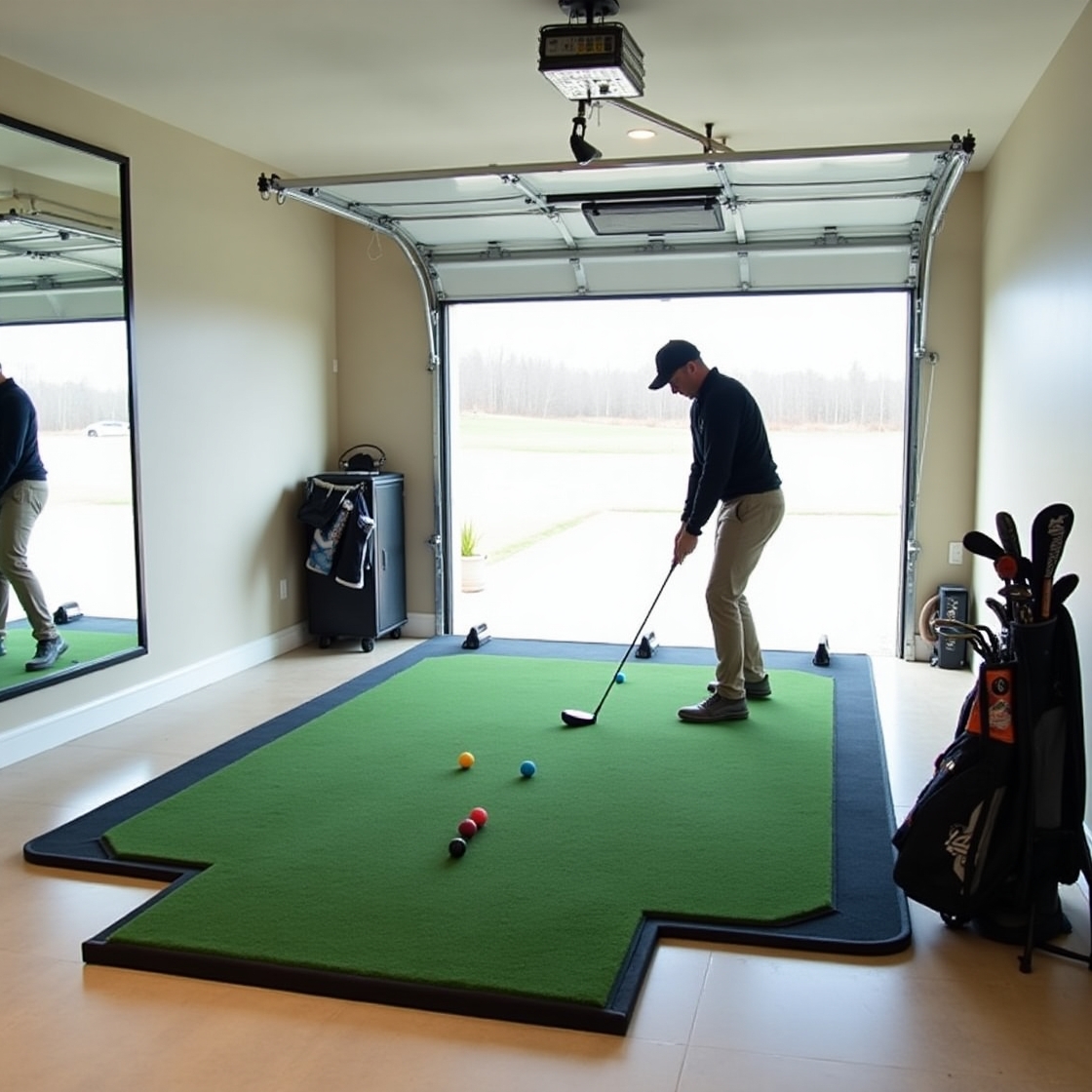
Table of Contents
Key Takeaways
- Home swing practice is especially useful because it allows you to fit in multiple short practice sessions into your hectic lifestyle. You can eliminate all that travel time to the range!
- Having a space to work inside rewards you with greater attention to detail. It keeps you focused and allows you to create muscle memory safely with repetition of drills.
- Using affordable equipment and items you already have around the house, your practice doesn’t have to cost a fortune. You don’t need a big area to practice at home!
- Performing a proper warm-up with dynamic stretches and mobility drills before each practice or match is key to avoiding injuries. It improves your overall swing mechanics!
- Keep your game face on Monitor your improvements with video feedback so you’ll never lose focus. Create focused objectives for each practice, and you’ll start to see measurable changes with each session.
- Stick to a disciplined process to prevent forgetting key steps. Don’t neglect any part of your game—put in practice every day with purpose and intention!
I use simple tools like foam balls, a mat, and a full-length mirror to spot weak spots in my swing. Home golf swing drills aren’t just a convenience, they’ll ensure you build muscle memory so your moves are fluid and consistent. Most of the drills don’t take up a lot of space, so you can do them in a garage, or in some cases, even a hallway.
You don’t need any expensive equipment—just move some furniture around and work on the fundamentals. Plus, you achieve genuine improvements in control and timing. Coming up, the best drills to practice in YOUR small space. These drills will ensure that your first shots back on the green are shots to be proud of.
Why Practice Your Golf Swing Indoors?
Practicing your golf swing indoors, at home, or even in an apartment, is perfectly suited to a busy, on-the-go schedule. We all know that blocking out time for the range or the course can be difficult enough. Other times, it’s just not practical.
Practicing indoors lets you work on your game from the comfort of home. It helps keep you accountable, even when it’s snowing outside or you’re too busy to visit the course. All you need is a place with at least 9.5 feet of ceiling height. Snag a few easy items such as foam balls or a practice mat, and you’re all set!
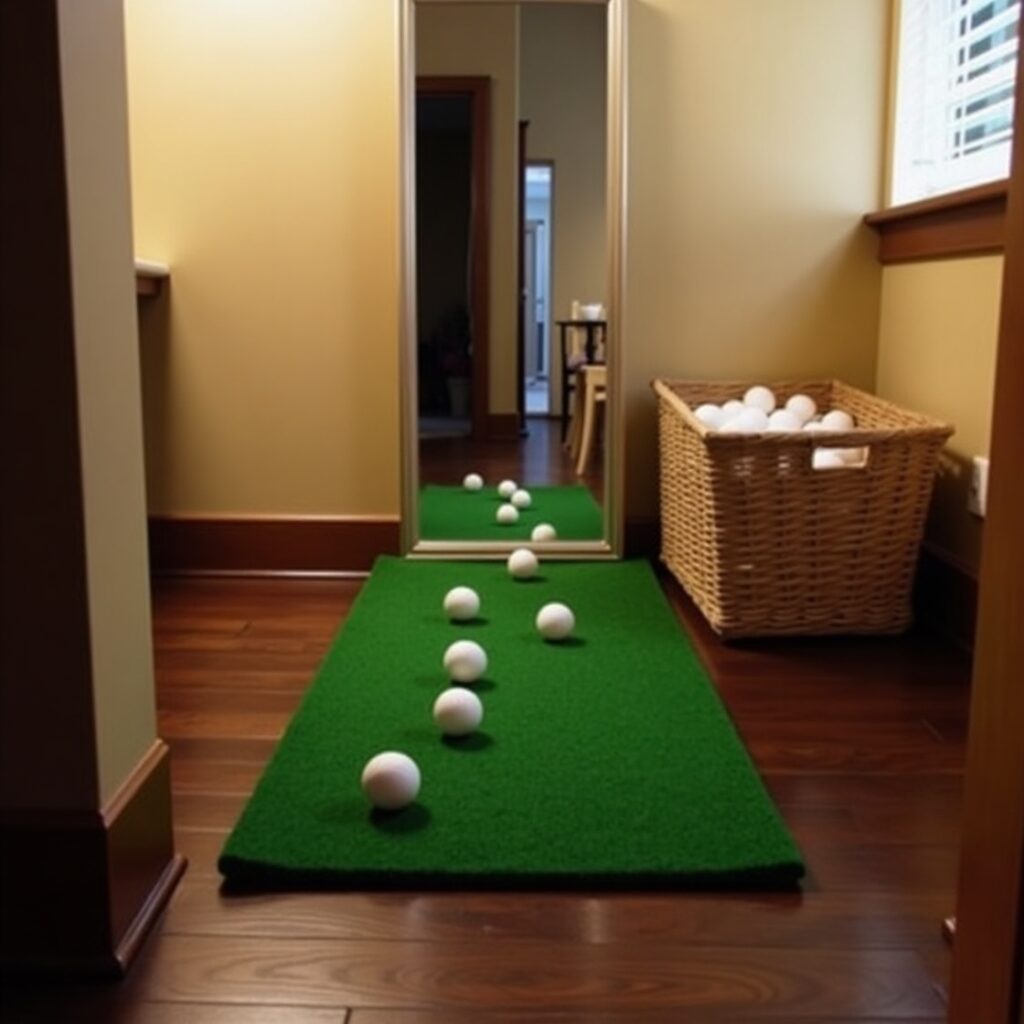
Place a basket or small bin roughly 10 feet away from you. This arrangement will allow you to improve your short game since you’ll be practicing hitting balls into it for precision.
Convenience Beats the Driving Range
Because practice sessions can be brief, it makes them convenient to squeeze in before work, after dinner, or on your lunch break. No need to account for commute time or adjust your calendar to accommodate range hours. Just five minutes of a swing drill makes a difference.
Practicing at home means you can work on your game any time you want, using what you have on hand. You avoid range fees and save gas money, going all the way to the driving range and back again.
Focus Without Distractions Easily
A calm location indoors serves as a great individual practice area. Without exterior distractions, you’re able to hone in on very specific objectives, such as creating a consistent swing or not lifting your head.
Work on visualization drills to get yourself mentally prepared for every shot. You remove yourself from a course atmosphere where you feel rushed or pressured.
Build Muscle Memory Faster
Repeating basic drills indoors allows you to zero in on your technique. Taking swings step by step, like practicing until you can hit a quarter with your clubface, helps increase your muscle memory.
Receiving feedback through video or mirrors allows you to identify errors quickly.
Cost-Effective Golf Improvement Method
You don’t need all the bells and whistles to improve your golf game. With free online videos and cheap training aids like alignment sticks, the price is low. Taking notes on your sessions will help you see how effective golf drills lead to consistent improvement.
Overcome Weather or Time Limits
Whether it’s rain, extreme heat, or just a packed day with family fun, nothing will interrupt your practice regimen. Indoor golf drills accommodate busy schedules, allowing you to maintain your golf game with basic equipment or small spaces.
Create Your Ideal Home Practice Space
When you have a home golf practice area, you can spend more time developing the right swing, day or night. When you create a practice dedicated space, you ensure every session is intentional and productive.
Whether you’re practicing indoors or outside, good lighting and a clear setup help increase your understanding of your grip and swing path. An organized space further reduces distractions and can help keep you injury-free.
Many people use a golf net or a portable simulator like the Garmin R10, which is small and costs about $600, to bring more realism to their practice. Have quick access to your gear by utilizing shelves or a rolling rack. That way, you’ll spend less time hunting for tees, balls or alignment sticks.
Find Enough Room Safely
You’ll want to measure your space to ensure you have enough room to swing a club unimpeded. If you’re getting an indoor swing, most need a minimum ceiling height of 9.5 feet.
A regular, two-car garage-sized workshop gives you enough room to install a hitting bay for clubs down to a 4 iron. Clearing the area of breakables and substituting foam or Izzo True-Spin Practice Balls are good mitigation strategies.
Do consider spaces with verticality and the ability to move.
Prioritize Safety Above All Else
Scan your environment before you power up. A floor mat such as a Fiberbuilt or DURA-PRO Commercial Golf Mat saves your joints and your floors.
A sturdy net, which you can get for as little as $70, prevents balls from flying everywhere. Do your best to avoid any windows and sensitive material.
Gather Essential Practice Aids
A practice golf mat and some inexpensive alignment sticks allow you to ensure a proper stance and swing path. New impact stickers provide instant feedback on your ball strike location.
Store a variety of practice aids/dots to add some variety to your repetitive drills.
Use Household Items Smartly
Chairs and walls can be your friends when it comes to maintaining good posture. Tape or floor markers indicate your target line.
Common household items can become useful practice guides.
Minimize Potential Indoor Damage
Water mats or rugs protect your floors. Work with foam balls and avoid fragile objects.
Inspect your setup regularly to avoid unseen dangers.
Warm Up Before Every Session
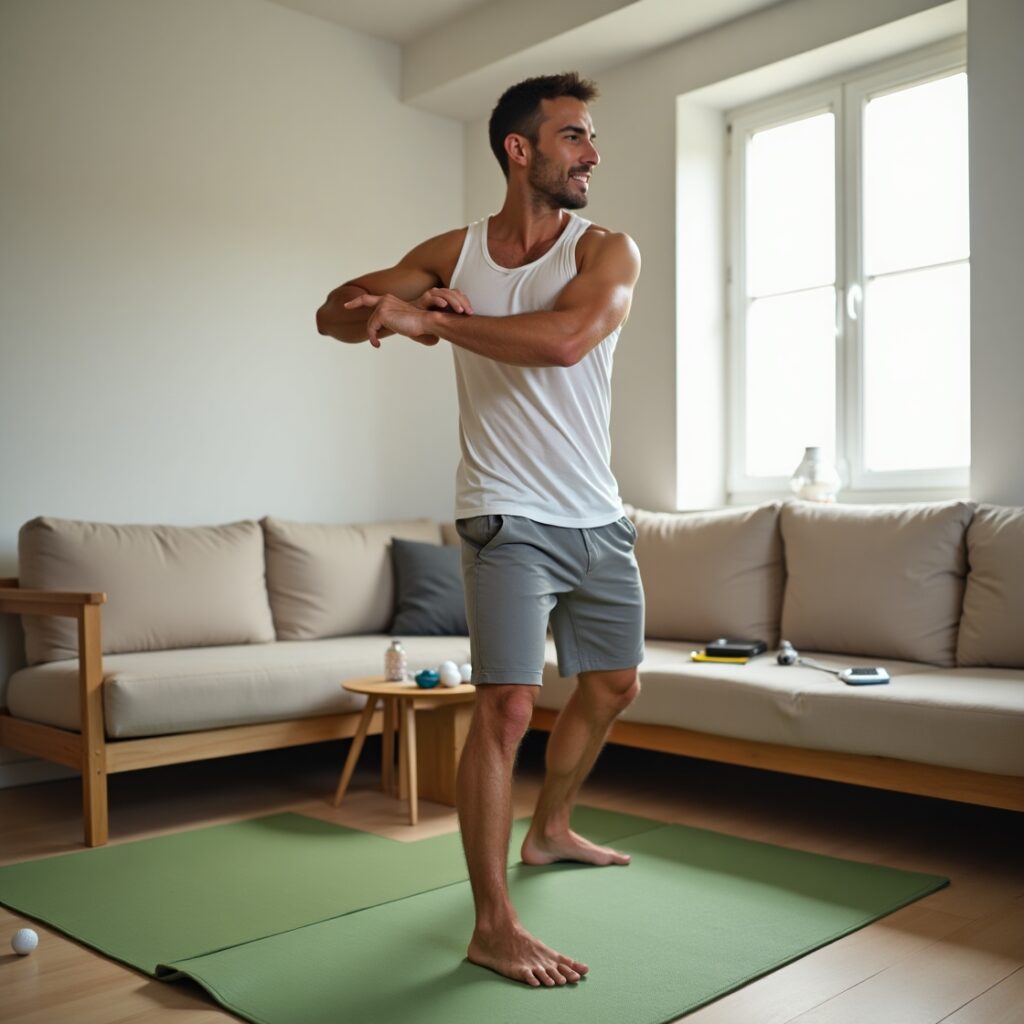
A good warm-up creates a positive expectation for each golf practice session at home. Even when I take two minutes max to do a few key dynamic stretches and practice movements, I definitely feel the difference. I find my swings smoother and my body more prepared for the next session.
This is the most important step that most golfers avoid. Research shows warm-ups based on movement are both more beneficial and less risky than static stretches. With a consistent practice routine, you have more predictability in your swing creating a more consistent Swing Equals Consistent Game.
Prepare Body with Dynamic Stretches
I begin with rolling my arms in small, then larger circles, releasing anything frozen in my shoulders and upper back. Incorporating indoor golf drills like rotating my body from side to side goes a long way in waking up and stretching the core, lower back, and spinal muscles. I also focus on my backswing to ensure proper form.
I begin with leg swings, alternating swinging my legs forward and backward. After that, I do dynamic lunges to fire up my quads and hip flexors. Some light jogging in place or a brisk walk outside is all it takes to get my heart pumping and blood flowing, setting me up for a great golf game.
I try to keep each stretch dynamic and avoid the long hold. That way, my muscles are loose and flexible to produce a full range of motion with my very first swing.
Improve Rotation Using Mobility Drills
Because golf swings require a lot of hip and shoulder rotation, I always include exercises that open up those areas. With a mini resistance band, I loop one end around a stationary object, grip the other, and rotate slowly, working stability and strength.
Planted feet torso rotations really make sure that I’m able to get a nice, fluid natural turn. I’m cognizant of my sense of balance, taking my time on every aspect of the drill.
In the long run, these motions really train my swing to be more connected from the ground up.
Start with Gentle Air Swings
With my muscles nice and toasty, I pick up my driver and start swinging it with half-speed deliberate practice strokes. Maintaining that concentration on clean movement pattern—shoulders, hips, arms all in sync.
As my body reacts, I start to run faster. These air swings allow me to visualize my desired movement and reinforce proper habits in warm up before getting into any actual swings.
Master Key Swing Mechanics at Home
By learning how to master your golf swing step by step, you’re able to isolate your efforts on what you can control first. Practicing at home provides an opportunity to practice efficiency and works to sharpen your skills even when time is at a premium.
With only a quarter of an hour a day, you’ll experience tangible benefits that will become evident the very next time you’re on the course or the links. Get creative with mirrors or short video clips on your phone to spot small tweaks. With practice, these small adjustments can make a huge difference!
Tools, such as Izzo True-Spin Practice Balls, along with some practice space, make it safe and effective to swing indoors.
1. Solidify Your Grip Fundamentals
With proper grip, you’ll have a better foundation for maintaining control of your swing and achieving better accuracy. Experiment with choking up on the club, gripping it lightly with different pressures and paying attention to what feels secure yet free.
Drills that keep you focused on your grip, such as practice squeezing and releasing the club throughout your swing, can keep you mindful. Using a mirror or cell phone, film your swing to review grip. Establish a different visual cue that allows your hands to look and feel the same every time.
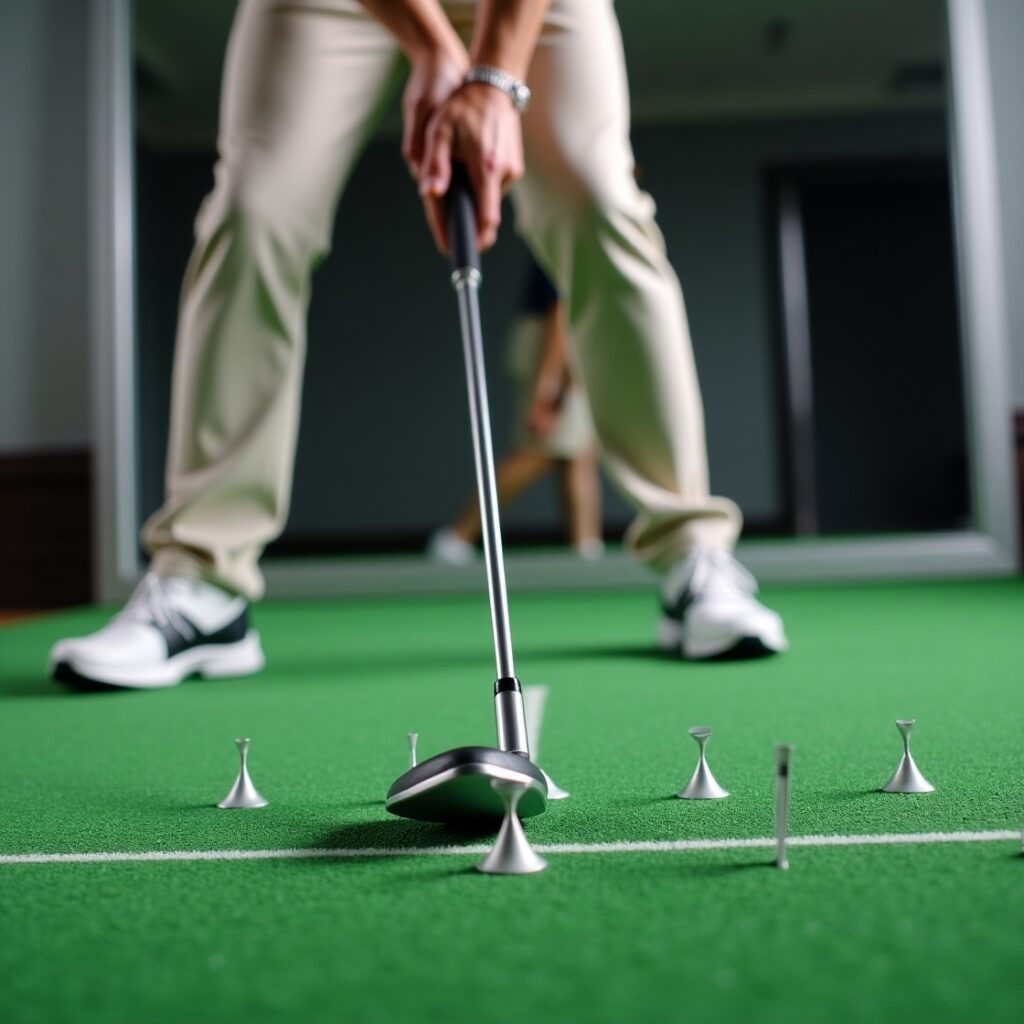
2. Perfect Your Stance and Posture
A solid foundation is a floor and wall that help you maintain the path of your swing. Using alignment sticks or even a broomstick can help verify that your feet and shoulders are aligned.
Proper posture, having a tall back and bent knees, contributes to a consistent swing. Viewing a video of your stance can help you identify areas where you need to stand more upright or bend at the waist.
3. Initiate a Smooth Takeaway
Take your swing from the very beginning with a deliberate, relaxed action. Arc the clubhead low, at first along the club’s perfect arc.
Short, controlled swings create a better foundation for the balance of your swing mechanics.

Targeted Drills for Game Improvement
When you practice golf at home, you get the chance to focus on the parts of your game that need the most work. So, I take a close look at my swing and short game to see what’s not right. Finally, I select drills that specifically target those weak areas.
Like, just by example, my swing path starts going crazy, or my chipping game gets a little unimpressive. For example, by working with targeted drills, you can bring up your skills overall, step-by-step. Because even 15 minutes a day is proven to help! You can already begin to visualize the effects the next time you play.
Full Swing Consistency Exercises
I employ my rhythm and timing drills to maintain the flow of my full swing. If I stay on tempo, it eliminates me speeding up. An advanced variation would be to set up a specific target and aim your shots.
Having done that, I find myself more accurate and farther from the target. Filming my swings on a cell phone allows me to pick up on patterns and make sure that I’m repeating things consistently every swing. My go-to drill for making sure my driver swing is up to snuff would be the Two-Tee Drill.
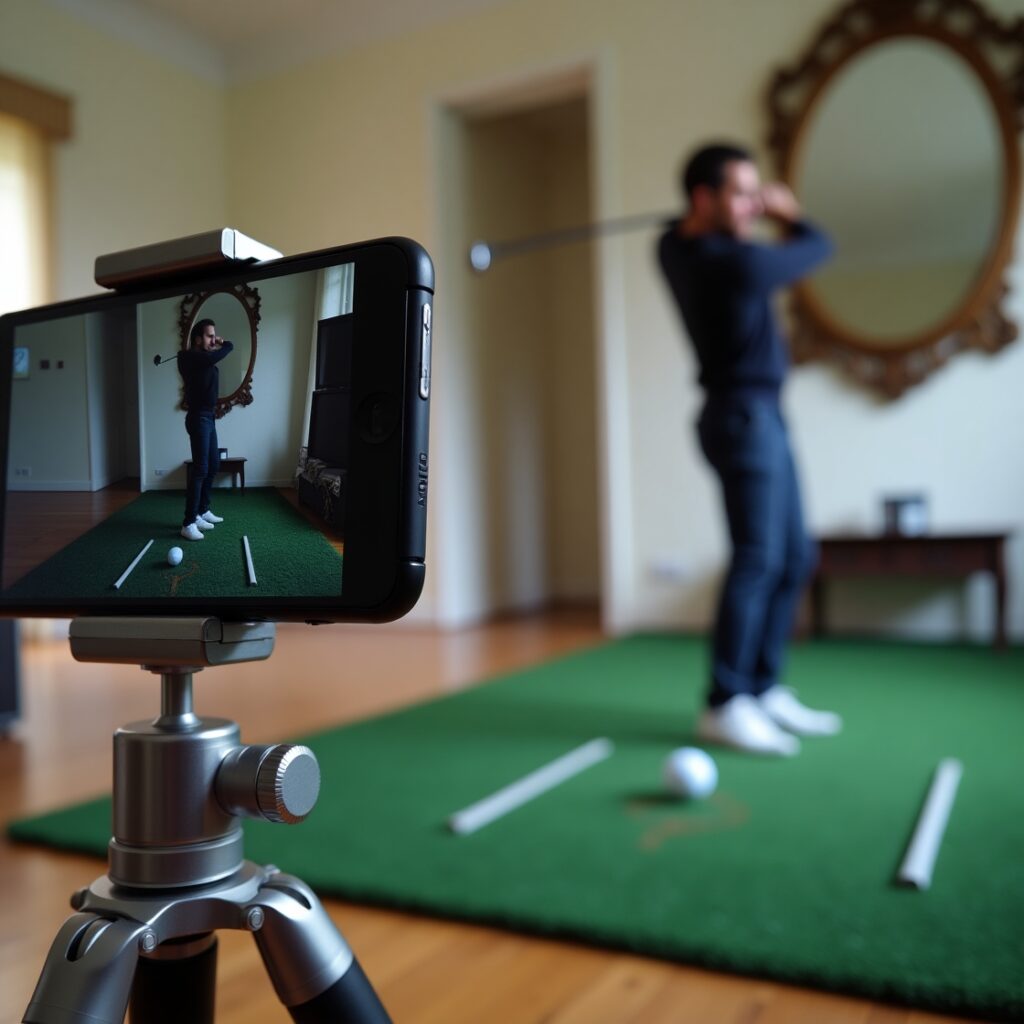
Short Game Chipping Techniques
For chipping, I alternate drills similar to the Ladder Drill and Box Drill to avoid monotony. Robin Symes recommends shooting for about a quarter as a target destination. This allows you to really dial in your touch and control.
By maintaining the same environment each time, you create more repeatability. By watching film on my own chips, I was able to see minor adjustments that had huge impacts in all facets of my game.
Putting Stroke Improvement Drills
The Gate Drill, placing two objects slightly wider than my putter, focuses and improves my stroke. I use the same stance and grip for every putt to create muscle memory.
Alignment aids and tracking my stats help me get a clear picture of how my putting improves over time.
Fix Common Swing Path Faults
I look at my swing path with video to see if I start to get off path. Targeted drills are invaluable in helping me eradicate these habits.
It’s important for me to maintain the same swing path in each practice round.
Control Your Low Point Consistently
I train with alignment aids, focusing on effective golf drills that enhance my weight shift and point of contact where the club enters the ground. By tracking progress and repeating indoor golf drills, I’m better able to control the low point with greater skill.
Leverage Simple Tools for Feedback
In your own home, you learn so much from very simple devices that provide very honest feedback. These simple tools quickly identify what’s working and what needs improvement in your swing. When you practice with feedback each time, you notice and correct those little nuances and imperfections and improve more quickly as a result.
Tools and tech allow you to understand your growth period over period to observe tangible results.
Use Alignment Sticks Creatively
Alignment sticks are a simple and confusingly effective tool to ensure you’re setting up correctly and swinging the club along an ideal path. If you’re using one on the wall, you can place one on the ground to test your foot, hip and shoulder line.
A second stick, angled out in front of you, helps you align your swing plane. Experiment parallel crossing two sticks to create a “wing gate” for your club. This gets you perfectly aligned so you swing straight and on the line to your target.
Make analog or digital notes after each practice to identify any deviation from your original configuration. Even small changes are apparent quickly when you test your tracks with these sticks.
Practice Before a Mirror
A mirror gives you the rare ability to see your swing in real time. You monitor whether your back is straight and if you’re holding your arms in the proper shape. Face sideways, stand on one foot and be sure your ankle is stable.

Put your back to the mirror to observe your shoulders and hand position on the wheel. Film your swing with your phone and review it on the range afterwards. It improves on-the-fly what you might otherwise overlook.
Get Impact Feedback with Tape
Put impact tape on your clubface to see where you’re striking the ball. Find any ticks on either side of the center line. If you find that you are getting hits on the heel or toe, time to fix your swing.
Extend this concept on drills that require you to hit the sweet spot. Keep track of your progress from round to round. After a few rounds, you should see your strike pattern start to tighten up.
Improve Accuracy with Chipping Nets
Chipping nets provide an easy way to take target practice to your short game. Aim for the easy areas within the goal. Add some target drills to work your short range and long range feel.
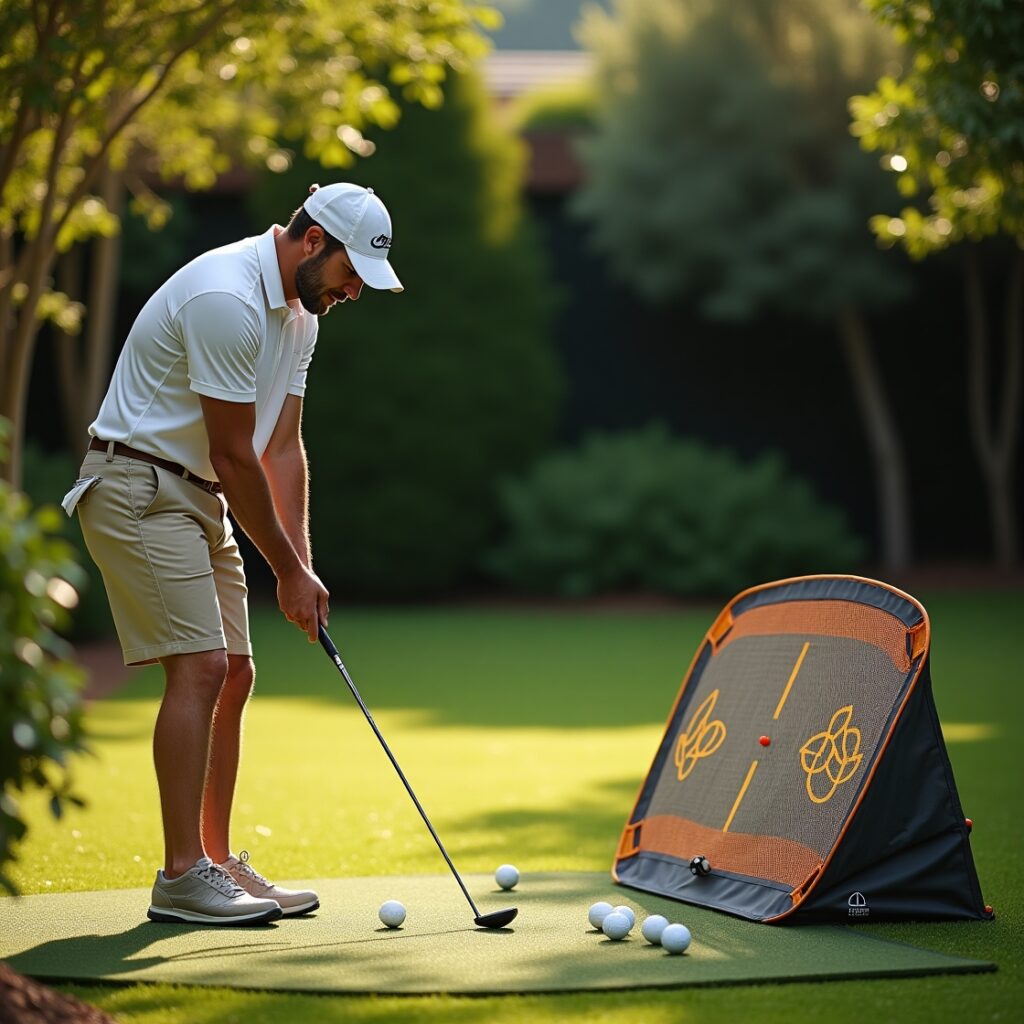
Tally on the back with an X each shared space you most frequently walk through. In a matter of a few weeks you will notice your accuracy and precision begin to sharpen.
You can connect your HackMotion while doing any of these drills. Wear it to record your wrist hinge and clubface angle for easy to understand feedback.
Even 15 minutes a day makes a difference and pays dividends on the course. To discover more helpful tips, register for our complimentary HackMotion Wrist Mechanics Guide.
Analyze Progress and Stay Focused
Maintaining your golf swing training off the course requires you to do more than just take a few swings at home. Incorporating effective golf drills, such as the backswing and downswing techniques, can help you reassess and reflect on progress made at the conclusion of each session. At the same time, identify what’s working, and adjust your practice accordingly to achieve even better results.
Measuring your impact, particularly at the mid-point in winter, keeps you focused and accountable, but allows you to realize just how far you’ve come. Over half the golfers on the PGA Tour rely on a HackMotion wrist sensor to receive unambiguous, immediate feedback about their swing mechanics and clubface control.
Twenty minutes of efficient practice with the proper drills, like the alignment stick drill, can produce far greater effects than an hour of haphazard work. This method allows you to maximize your output while preventing burnout.
Record Your Swing on Video
Filming your swing with your smartphone provides the most clear and brutally honest feedback. You can quickly identify bad habits to break and figure out what’s working and making your game awesome.
Watching your swings side by side with those of pro golfers, you can notice things like wrist angles or clubface position. After a few months of shooting, turning back through your initial videos will reveal tangible difference, keeping you focused and improving.
Incorporate Mental Game Practice
That’s where a strong mental game really helps. Develop the habit of visualizing your shots before you bite and create mental and physical goals.
Just a minute or two of intentional breathing or a brief pause can prevent stress from building. Having an optimistic outlook—not letting anything go by without being positively challenged—instills a culture of confidence and discipline.
Set Achievable Practice Targets
Have a purpose in mind for every session. Set goals to make a targeted number of shots with a square clubface or work on increasing your carry distance.
Narrow down each practice to clubface control, speed training, and trajectory movements to break monotony and maintain productivity.
Track Your Improvement Trends
Have a practice log to keep track of what you focused on, how it felt, and what you got out of it. After only a few weeks, you’ll begin to notice trends – perhaps more repeatable ball flight or improved distance control.
Onward to celebration! Celebrate these wins enlivening your campus and community, and leverage the data-driven progress to update your plan.
Avoid These Home Practice Mistakes
It’s very easy for accomplished players to develop poor practice habits and regress without realizing it. To improve your golf game, create a good strategy and incorporate effective golf drills like the backswing and downswing alignment stick drills. When you know what you’re looking for, you can sidestep dangers and distractions while keeping your eyes on the prize.
Rushing Through Setup Routine Steps
Many get anvil or forge and skip these critical setup steps to start swinging. When you take the time and slow down to consistently relax your grip and assume the correct stance that’s a muscle memory you’ll develop.
For home practice, I really enjoy a very simple checklist—feet in line, shoulders straight, strong handhold. This ensures you catch little mistakes before they develop into more serious problems. One example is the “Butt Back Drill.” It trains you to maintain your address position throughout the swing.
It helps you maintain a neutral hip and spine posture. Initially, many golfers feel very uncomfortable making this move. Man, does it blow up mistakes like attempting to lift the ball or resisting your body’s rotation.
This drill is beneficial for the players who consistently hit fat shots, which is upwards of 80% of all golfers.
Trying to Swing Too Fast
A lot of golfers attempt to swing fast in order to generate additional distance. This overwhelmingly results in a too big of an inside-out swing, which is the number one culprit of a slice.
Slow, quiet, smooth swings with a metronome lead to much less explosive positions. Choose exercises that emphasize groove. If you are practicing at home and need to swing aggressively but have the potential to hit something (like an ottoman), slow yourself down.
Use slow motion to increase your tempo.
Forgetting About Short Game Skills
It’s tempting to only practice full swings, but don’t forget that your chipping and putting require practice as well. So I spend time working on short game drills.
I practice indoors on a carpet or putting mat, despite the fact that the speed won’t be the same as on an actual putting green. Keeping track of your progress here helps you identify where you need to focus your time and energy.
Practicing Without Specific Goals Daily
Each lesson should have a achievable, specific goal—for example, making contact first, or maintaining the tempo. I’m constantly tracking my progress and changing routines as necessary.
This ensures that practice remains focused and outcomes readily apparent.
Conclusion
Home and yard swing improvements translate directly to the golf course. Having a mat and some room at home means you’re always ready to stay on top of your game. You first learn the correct feel for grip, stance, and tempo—as you would in a traditional golf practice experience—right in your living room or garage! Those small intentional steps you take every day lead to big results quickly. You see the ball go straighter and your body is aligned with that shot. Even having a mirror or phone to film it on goes a long way to just identify those minor adjustments.
Minimal equipment required. No expensive equipment or large space needed. You avoid getting derailed, you avoid reverting back to your former ways, and you experience authentic transformation. Looking to maintain your competitive advantage? Begin those swing drills this evening and make your next round of golf feel much more fluid. Your game develops where you home—take a swing and see it rewarding.
Frequently Asked Questions
What are the best golf swing drills to practice at home?
Work on slow-motion swings, mirror work, and balance drills to improve your golf game. These effective golf drills develop muscle memory and enhance your chipping motion without requiring a lot of space or equipment.
How much room do I need to practice my golf swing indoors?
A minimum of 8-foot ceiling height and a 6 x 6 foot clear area is essential for practicing effective golf drills, allowing golfers to take a full swing without hitting the walls or the ceiling.
Can I improve my golf game by practicing indoors?
You have to be in love with the work. Engaging in indoor golf drills on a consistent basis allows you to lock down swing fundamentals, improve your ball striking, and develop the confidence needed to excel when you hit the course.
What equipment do I need for home golf practice?
Begin with a golf driving mat, a golf hitting net, and an alignment mirror. Incorporating effective golf drills, such as using alignment sticks or weighted clubs, can provide extra benefit, but aren’t necessary.
How can I track my progress with home golf drills?
Use your smartphone to film swings or purchase an entry-level launch monitor, which is a great way to analyze your backswing and downswing. Watching yourself compared to pros, you’ll catch mistakes and in time see the results of your hard work take effect.
Are there any common mistakes to avoid when practicing golf at home?
Yes. Don’t hit actual balls in confined areas, and avoid skipping warm-up routines or practicing with bad form, as these can lead to injury or allow bad habits to creep into your golf game.
Which feedback tools are most useful for home swing practice?
Mirrors, alignment sticks, and phone apps are terrific feedback mechanisms for indoor golf drills. They allow you to visualize your strike and improve your golf game by making necessary adjustments.






